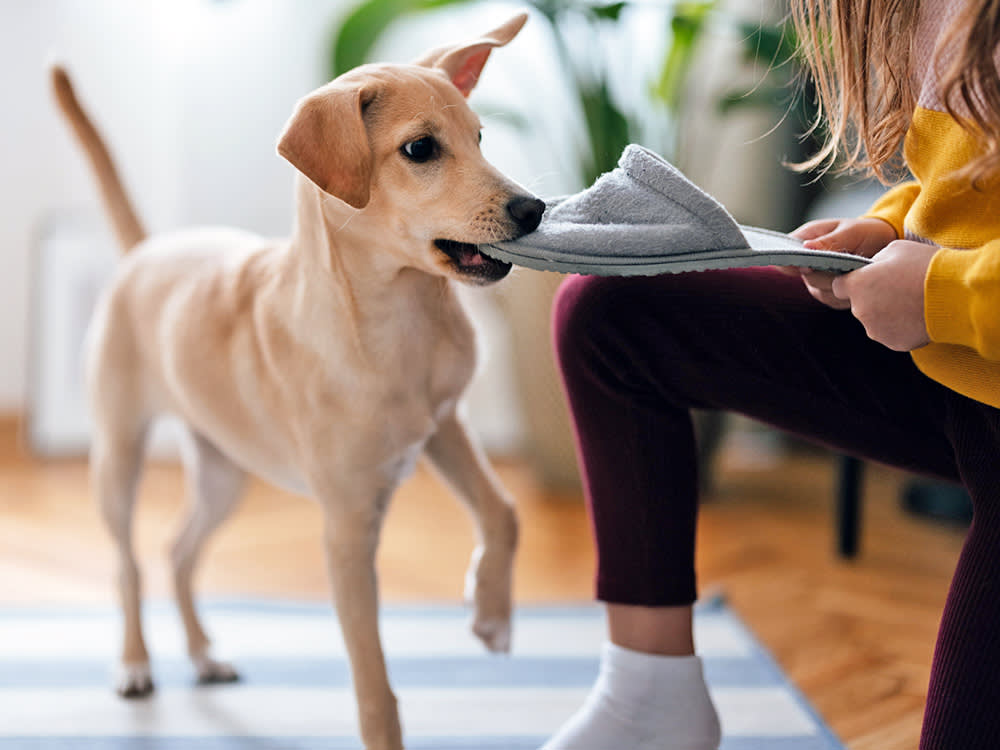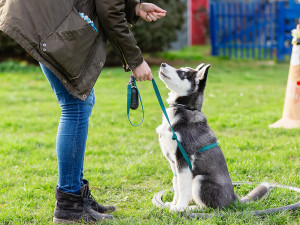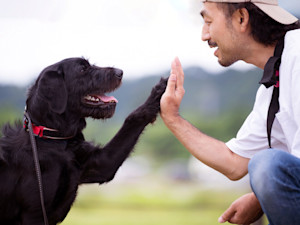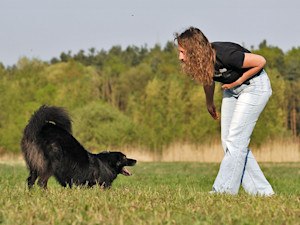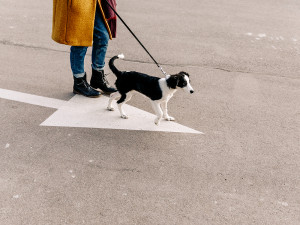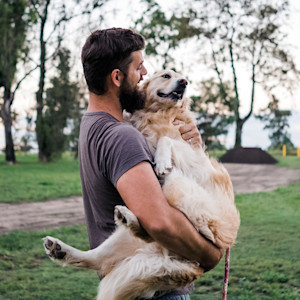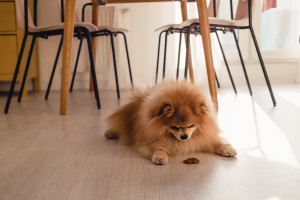How to Teach a Dog to “Drop It”
The most important cue your dog doesn’t know. Yet.
Proper training is as important for your dog’s wellbeing as food, rest, and exercise. Training helps them understand the world around them and their place in it and opens up essential lines of communication between you. It’s also a much-needed form of mental stimulation and, when done properly and positively, can be as fun for your dog as play timeopens in new tab.
Ideally, training should begin earlyopens in new tab, when your dog is still a puppy, and be reinforced through daily repetition, but it is never too late to train your dog. The old saying that “you can’t teach an old dog new tricks,” is just flat-out wrong. With compassion and dedication and the right treats, you can teach an old dog just about anything. And if there’s one command dogs of all ages need to know, it’s “drop it.”
Trick question: All dogs are perfect! But find out which type is the best fit for you.
Why you should teach your dog to “drop it”
“In my opinion, ‘drop it’ is one of those lifesaving commands every dog should know,” says Annie-Mae Levy, a professional dog trainer at Woofzopens in new tab. “It’s important because it helps you take control in situations where your dog picks up something dangerous like a piece of food they shouldn’t eat, a toxic plant, or even something sharp.”
“Drop it” is also handy during playtime. As anyone who has ever tried to play fetchopens in new tab can attest, fetch with a dog who doesn’t know how to drop what is in their mouth can turn from fun to frustrating pretty quick.
How much do you spend on your pet per year?
What you will need
When teaching your dog to “drop it,” Levy suggests having some treats, a toy they enjoy playing with, and a clicker if you use clicker training. “The treats act as a reward for giving up the item, and the toy makes it fun for them to engage with you,” Levy says. “The key is making the trade worth it for the dog, so you need to have something better than what they’re holding.”
If you’re struggling to find a properly motivating treat, try the viral muffin-tin trick to figure out which treats are of the highest value to your dog. The results might surprise you.
Steps to teach your dog to “drop it”
When training a new skill, it is best to limit any additional stimuli that might make it difficult for your dog to focus. So, if your yard is full of squirrels your dog likes to chase, train new skills inside. If the living room is too rowdy, move your training session into the bedroom and close the door. The easier you can make it for your dog to focus, the faster they will learn and the easier it will be for you to retrain the skill in new and more hectic environments.
Step 1: Gather the supplies.
Make sure you have everything (treats, toy, and clicker) set up and ready to go before you bring your dog into the training space. Doing so should help you feel more calm and focused, which, in turn, should help your dog feel more calm and focused.
Step 2: Offer them a toy.
“Use a toy your dog likes but isn’t obsessed with,” Levy adds. You want it to be something appealing, but not as appealing as the treat you’re going to give them when they drop it.
Step 3: Tell them to “drop it.”
Let them hold the toy for a few seconds, then offer them a treat while saying “drop it.”
Step 4: Praise them for a job well done.
When they release the toy, give them the treatopens in new tab and whatever verbal or physical praise to which they respond best.
Step 5: Introduce a hand command.
Make a fist, and point it toward your dog, then, while saying “drop it,” open your hand as if dropping something. When your dog obeys, reward them like before. Over time, you can even phase out the words “drop it” all together.
Now your dog will have a verbal and non-verbal cue for the same command, which will help reinforce the command in their mind and give you options when you’re out in the world.
Step 6: Phase out the treats.
Once they are obeying properly, begin phasing out the treats, but keep giving them verbal or physical praise like before. Over time, they will associate obedience with feeling good and should need little to no additional reward for following your commands.
Step 7: Practice “drop it” often.
The keys to training any dog are regularity and repetition. Ideally, you should practice your dog’s obedience skills every day, and not just at home. Commands like “drop it” are often most useful outside the home anyway — when you’re on a walk or at the park — so it is essential that you retrain these skills in all the different environments where your dog spends time. Just because they can “drop it” at home, when no one is around, doesn’t mean they can do the same thing at a busy park or in the vet’s office. That’s not how a dog’s brain works. Keep treats on you at all times and try to view every new space you enter with your dog as
an opportunity to reinforce their training.
When to get help from a trainer
Training a dog can be tough, so if you are struggling, seek professional help. “I’d suggest seeking help from a trainer if your dog consistently refuses to drop items, shows signs of resource guardingopens in new tab, or if you’re feeling frustrated with the training process,” Levy says. “A professional can assess why your dog isn’t responding and give you tailored advice.”
Professional help is also essential if your dog is acting aggressive towards you during the training process. Do your best not to respond to their aggression with anger or violence and instead seek professional help sooner rather than later. “It’s better to address those kinds of issues early before they become more serious,” Levy warns.
It’s also important to communicate your dog’s training needs to the people around youopens in new tab — friends, family, dog walkers, etc. — so they can help, rather than hinder, you in your efforts. Dog training is important and it’s hard work and the people in your and your dog’s life should support what you’re doing, even if it means they can’t necessarily interact with your dog in the way they want to.
FAQs:
What if your dog won’t drop something dangerous?
If your dog grabs something dangerous, like chocolate or a sharp object, and won’t drop it, first and foremost, you must remain calm. “Avoid turning it into a chase or tug-of-war,” Levy says. “In my experience, sometimes offering a higher-value treat or toy can entice them to release it. If that doesn’t work, gently restraining them and carefully removing the object might be necessary, but it’s best to try to avoid panicking and escalating the situation.”
How long will it take to train a dog to drop it?
“Honestly, it always depends on the dog,” Levy says. “But with consistent practice, most dogs can get the hang of it within a couple of weeks.”
That said, it could take longer to fully master this skill if your dog is more stubborn or attached to certain toys or other items in your home. “The key is patience and making the training sessions short and fun so they stay engaged,” Levy says.
What should you do if your dog refuses to drop it?
“Try switching up your approach,” Levy says. “Maybe the treats you’re using aren’t enticing enough, or the item they’re holding is too high-value. You could also practice more in low-distraction environments until they get more consistent.”
Don’t make it a battle of wills: Just calmly reset and try again later with something easier for them to let go of.
How do you make training a dog fun?
“Making training fun is all about keeping it light and rewarding,” Levy says. “Use toys your dog loves and plenty of treats, and don’t be afraid to add in play breaks during the session. Dogs love games, so if you can turn “drop it” into part of a fetch or tug game, it keeps them engaged.”
And remember that dogs pick up on your energy: so praise and excitement can go a long way too.
What if the dog gets aggressive when trying to take something away?
“If your dog gets aggressive, it’s important to back off and assess the situation,” Levy says. “Resource guarding is a common issue, and pushing the dog too hard in those moments can make things worse.”
Instead of forcing the issue, try working on trading up and offering them something even better than what they’re holding. If your dog shows consistent aggression, it’s a good idea to consult with a trainer who specializes in behavior issues. “Aggression can be tricky to handle on your own and you might face repercussions for uncareful actions,” Levy warns.
Whatever you do, don’t give up. The harder your dog is to train, the more important training is. Remember that dog’s don’t misbehave out of spite. They are confused and scared and desperate to communicate and it is up to you to put in the work required to help them.
